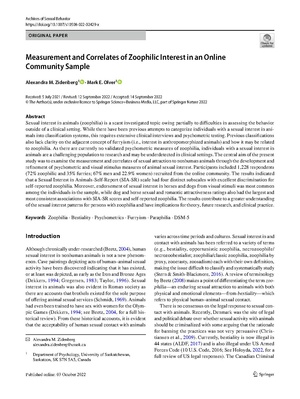Measurement and Correlates of Zoophilic Interest in an Online Community Sample
Alexandra M. Zidenberg[1] · Mark E. Olver

Received: 5 July 2021 / Revised: 12 September 2022 / Accepted: 14 September 2022
© The Author(s), under exclusive licence to Springer Science+Business Media, LLC, part of Springer Nature 2022
Abstract
Sexual interest in animals (zoophilia) is a scant investigated topic owing partially to difficulties in assessing the behavior
outside of a clinical setting. While there have been previous attempts to categorize individuals with a sexual interest in ani-
mals into classification systems, this requires extensive clinical interviews and psychometric testing. Previous classifications
also lack clarity on the adjacent concept of furryism (i.e., interest in anthropomorphized animals) and how it may be related
to zoophilia. As there are currently no validated psychometric measures of zoophilia, individuals with a sexual interest in
animals are a challenging population to research and may be underdetected in clinical settings. The central aim of the present
study was to examine the measurement and correlates of sexual attraction to nonhuman animals through the development and
refinement of psychometric and visual stimulus measures of animal sexual interest. Participants included 1,228 respondents
(72% zoophilic and 35% furries; 67% men and 22.9% women) recruited from the online community. The results indicated
that a Sexual Interest in Animals-Self-Report (SIA-SR) scale had four distinct subscales with excellent discrimination for
self-reported zoophilia. Moreover, endorsement of sexual interest in horses and dogs from visual stimuli was most common
among the individuals in the sample, while dog and horse sexual and romantic attractiveness ratings also had the largest and
most consistent associations with SIA-SR scores and self-reported zoophilia. The results contribute to a greater understanding
of the sexual interest patterns for persons with zoophilia and have implications for theory, future research, and clinical practice.
Publisher's note
Publisher's Note Springer Nature remains neutral with regard to
jurisdictional claims in published maps and institutional affiliations.
Springer Nature or its licensor holds exclusive rights to this article under
a publishing agreement with the author(s) or other rightsholder(s);
author self-archiving of the accepted manuscript version of this article
is solely governed by the terms of such publishing agreement and
applicable law.
References
https://doi.org/10.1007/s10508-022-02429-x Alexandra Zidenberg, PhD Department of Psychology. Overseen by Prof. Dr. Mark Olver.